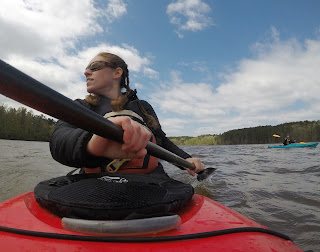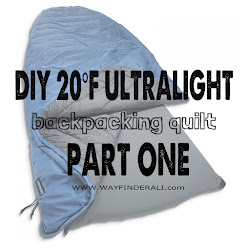A harsh morning for a paddle.....
 |
| Looks like a lovely morning doesn't it? Looks can be deceiving. |
Last week, a few of my fellow instructors and I got together on Falls Lake for some pre-season paddle training.
We began our session huddled and shivering at a picnic table, discussing our plans for the summer. The bright sun did little to warm us in the chilly 43-degree air while the howling wind sucked our heat away as it moved through the fabric of our jackets.
Changing Plans
Most of us were dressed in wool and fleece layered beneath wind and rain jackets. Few of us own neoprene wetsuits and still fewer have dry suits. Our original plan for the day was to review wet exits and rescues with newly hired instructors. The water was only 60 degrees, and with such a low wind chill, the likelihood of hypothermia for those of us without neoprene was high. We decided to postpone our skills session for a warmer day.
It's rare for all the instructors to be together, and with a trailer full of boats and boards, we couldn't resist getting out on the water together. We are all professional paddling instructors, with the ability to manage the risks we were taking and the knowledge and skills we needed to stay safe ourselves should one of us accidentally end up in the water. Our decision to paddle was based on knowledge, technical skill, available safety equipment, and experience.
That looks bad.....really bad
Typically at this specific location on Falls Lake, we turn right from the boat ramp, but for some reason (maybe the wind) we decided to turn left. Unbeknownst to me, we were heading toward something floating in the water, that another instructor thought was trash.
Upon inspection, they discovered it was a kind of improvised fishing device that used part of a pool noodle in the design. While they floated and talked by the pool noodle, Cameron and I bobbed next to each other, pointed in a different direction from the group.
We watched a lone fisherman in a canoe catch a large fish. Cameron reckoned it was a catfish, but we were too far away to know for sure. I think we were about 100 yards away from him at the time.
I looked away, back toward our group, when Cameron spoke up.
"Did that guy just jump out of his boat?"
I thought to myself. No one jumps out of their boat in these conditions. I turned my head to see the fisherman in the water, swimming violently toward his boat, which sailed away from him much faster than he could swim. In winds like those, it is impossible for anyone but maybe Michael Phelps to swim fast enough to catch an empty canoe.
My second thought was that we would need to recover his boat and bring it back to him. Within seconds it became very clear that the man was in distress. His movements changed from obvious forward strokes to thrashing, and then to desperate attempts to keep his face above water. Without a lifejacket, the layers of cotton clothes he wore and his heavy boots dragged him down.
Cameron and I began sprinting toward him as fast as we could. His face submerged several times, and I worried that we wouldn't get there before he lost consciousness. Luckily, he was strong and fought long enough for us to get to him.
Cameron and I presented him with the bow (front) of our kayaks. This is the safest place for a swimmer to hold onto the kayak. One should never present a distressed swimmer with the side of a kayak, as the swimmer is likely to flip the boat over with their weight. He was exhausted when we arrived and could hardly talk for being so out of breath.
Lisa (of Distressed Mullet) appeared almost instantly on her paddleboard. I couldn't believe how fast she got to us, but she does race paddleboards, so I shouldn't have been surprised. She knew it would be easier to get him up onto her paddleboard than onto one of our kayaks. Meanwhile, Brett (of Adventure Otaku) went after his boat.
When the swimmer caught his breath, we asked him questions, including his name. We'll call him Jay to protect his privacy.
When Lisa arrived, and I knew Jay would be ok, I thought to turn on my GoPro and focus it on the action.
Jay used Cameron's bow and Lisa's paddleboard to hoist himself onto the board. Paddleboards and kayaks are designed to hold the weight of one person and can become very unstable when you double the load. I was concerned about Lisa flipping with the extra person on her board, so I kept my bow next to Lisa to help her balance. I was impressed by Jay's ability to push himself and his heavy clothing up out of the water. This isn't an easy thing to do, especially after swimming in heavy clothing.
Moments later, Brett arrived with Jay's canoe in tow. After introducing himself, he began a patient assessment. Brett is an EMT and was concerned about not only hypothermia but also worried that Jay may have hit his head on his boat when he fell. We listened as Jay told us how he caught a big fish and was trying to get a photo of it when he dropped his phone overboard. He fell out of the canoe lunging to catch the phone.
 |
| Brett asks Jay questions about what happened and how he's feeling. It seems that Jay is beginning to realize the severity of what just happened. |
After finding out that Jay had not hit his head, Brett decided it is best to put him back in his boat and get him to land. Jay's shivering was becoming more violent and hypothermia was setting in. Brett noticed a 6 pack of beer in his canoe but wasn't able to count open containers.
We got him back in his boat but wanted to get him in a life jacket. There was no life jacket in his canoe. His friend wasn't wearing a life jacket either but had one in his kayak, which he handed to him. In a situation like this, most instructors would tow the person back to shore, but after finding out the canoe had a small motor, we agreed to let his friend accompany him back to land.
| Brett and Lisa stabilize J's canoe while he climbs back in. I float nearby to support Lisa. |
Back on shore, Jay changed out of his wet clothes and into his friend's spare clothes. He vomited up lakewater several times but was otherwise ok after warming up in the truck. Both Jay and his friend thanked us and swore they would always wear life jackets from then on.
A Lucky Break and Lessons Learned
Jay made several decisions that day that, when combined, would have cost him his life. The only thing that prevented loss of life was the coincidence that we happened to be on the lake that day, at that time, and were close enough to respond rapidly enough to keep him from drowning.
Whenever anyone makes mistakes, it is important to learn from them so we can prevent them in the future. Let's review the decisions that caused Jay's brush with death.
1. Paddling in conditions beyond his skill level
The conditions on the water (the wind and chop) made it much more likely that one of them would flip over. Jay and his friend did not know how to rescue each other safely if one of them had flipped over, and neither knew how to safely rescue someone in the water.
2. Not wearing a PFD / Life Jacket
Most of us who paddle usually consider ourselves decent swimmers, but when faced with an unexpected swim of several hundred yards many of us would come up short. Combining cold water and heavy clothes can make swimming even several yards extremely difficult. A personal flotation device (PFD) keeps your head above water without any effort from you. If Jay had been wearing a PFD, he could have leisurely swum back to shore and worried about retrieving his canoe later. He would have been nearing hypothermia, but he wouldn't have drowned.
2. Not wearing proper clothing
Whenever dressing for a water activity, it is important to dress for immersion. This means wearing garments that will keep you warm even when wet and won't become too heavy when saturated. Wearing proper clothing would have kept Jay warm both in and out of the water, and wouldn't have dragged him down.
3. Drinking
We don't know if Jay and his friend had actually drunk any of the beers in his canoe. Alcohol compromises our ability to make good decisions, our reaction time in emergencies and our sense of balance. All of these abilities are critical to staying safe on the water.
4. Paddling too far from 'paddling buddy'
No one should ever paddle alone. Jay and his friend had a false sense of security because they were out on the water together. The problem was that they were so far apart, Jay's friend didn't know what was going on until he heard people on the fishing dock yelling as they watched Jay struggling to swim. Jay's friend would not have gotten over to him fast enough to prevent drowning. Even if his friend had been close by, without proper training it was likely his friend would have flipped trying to rescue him, and without his life jacket on, his friend may have also drowned.
Mistakes I made:
1. Not bringing a tow line
With so many instructors on the water, I neglected to bring a tow or throw line because three other instructors were equipped with them. In hindsight, if I had needed to go get Jay's boat, I would have had nothing to tow it with.
2. Watching for too long
As soon as I saw Jay in the water I should have immediately begun paddling toward him. Instead, I waited several seconds until I saw he was in distress. Those seconds could have made the difference between life and death for him had be not been as strong.
Related Posts:
Mistakes I made:
1. Not bringing a tow line
With so many instructors on the water, I neglected to bring a tow or throw line because three other instructors were equipped with them. In hindsight, if I had needed to go get Jay's boat, I would have had nothing to tow it with.
2. Watching for too long
As soon as I saw Jay in the water I should have immediately begun paddling toward him. Instead, I waited several seconds until I saw he was in distress. Those seconds could have made the difference between life and death for him had be not been as strong.
Did you enjoy this post? Do you find my blog helpful? Help me keep this blog going by buying me a 'coffee'







